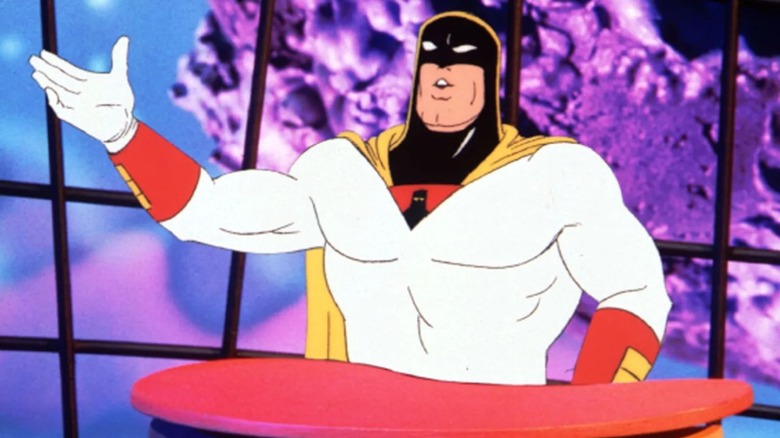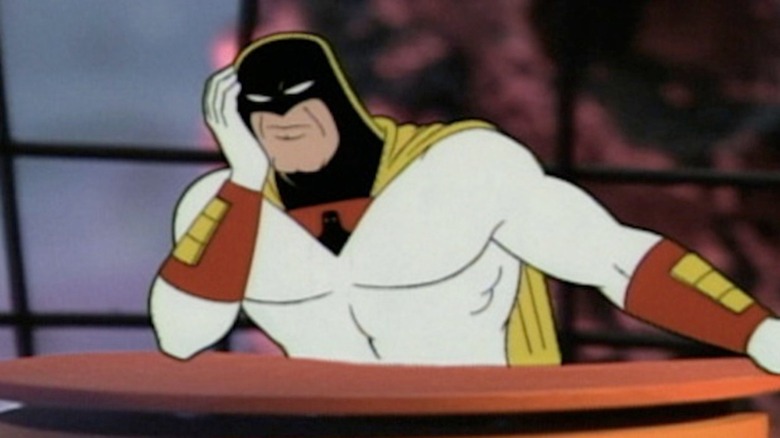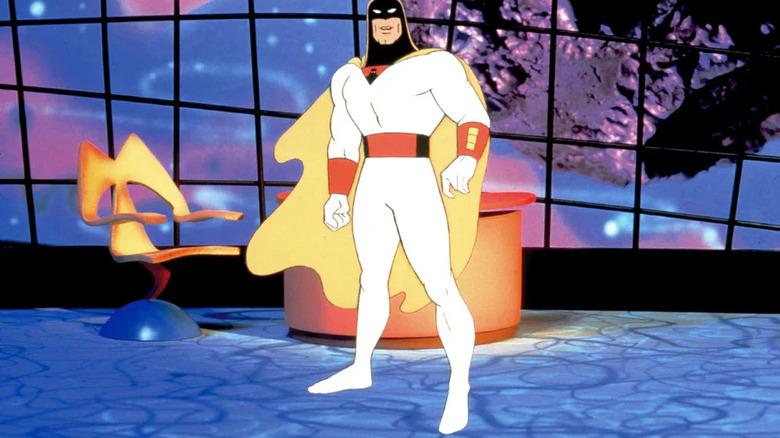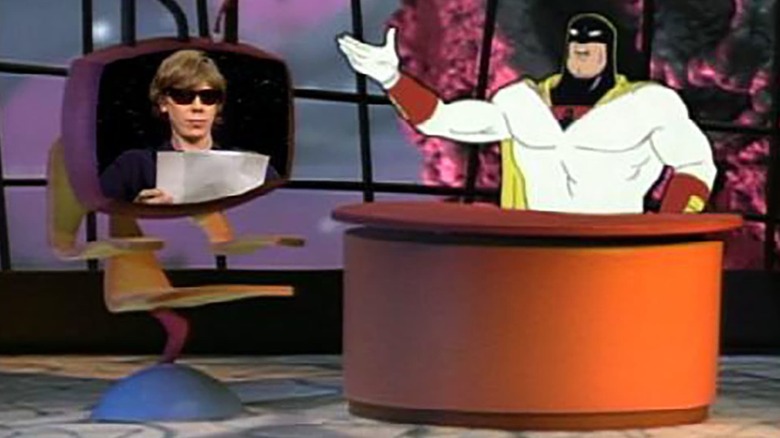How Cartoon Network's Space Ghost Coast To Coast Made History
To quote Space Ghost himself, "I'll be dead long before you were born, and I'll be dead long before you'll be dead."
In 1994, producer Mike Lazzo donned a pith helmet, filled his arms with machetes, and trekked into the darkest corners of the bleak, terrifying Hanna-Barbera cartoon library. In the depths, he re-discovered a long-forgotten, one-season animated series from 1966 called "Space Ghost," a superhero show about a white-clad, cape-wearing starship captain who fought bud-like villains in the inky void of the cosmos. Space Ghost, voiced by Gary Owens, could pass through walls and oversaw a pair of sidekicks named Jan (Ginny Tyler) and Jace (Tim Matheson) as well as a chimp named Blip (Don Messick).
Like most of Hanna-Barbera's output, "Space Ghost" was strange and awful. 20 years later, reruns of shows like "Space Ghost" were increasingly enjoyed exclusively by college students under the influence of potent smokables. One would be hard-pressed to find '60s kids earnestly and aggressively fond of "Space Ghost."
Lazzo brought Space Ghost to the Cartoon Network in an age of increased irony, aiming to put a new spin on the character. What if Space Ghost, after retiring from superherodom, was allowed to host his own chintzy late-night talk show? And what if his former nemeses were now his producer and his band leader? And what if we could composite live-action footage of real celebrities into the show to make it look like an animated character is interviewing someone in real time?
And, most importantly, what if this was all presented as an ambitious, wild, neo-Dadaist art experiment that aimed to tear down the walls of media and flood human consciousness with sheer, reality-stripping absurdity?
Thus, "Space Ghost Coast to Coast" was born. And it became the bedrock of a generation of entertainment.
'90s punk rock animation led to Space Ghost Coast to Coast
In the early 1990s, animation was turning inside out. Reagan-era cartoons were losing favor as many young audiences began to key into their crass commercialization (it was common in the 1980s to invent a toy product first and then extrapolate an animated series-cum-30-minute-TV-commercial from it). In 1990, Steven Spielberg reset the clock in the commercial world with "Tiny Toon Adventures," a series that regularly broke the fourth wall and openly declared the 1980s to be over at long last. Then in 1991, John Kricfalusi rewrote the map with "The Ren & Stimpy Show," an aggressively crass and strange series that proved animated shows could be creator-driven and not commercially motivated. John K. was eventually revealed to be a creep, but his influence on animation in the 1990s remains immeasurable.
Meanwhile, over on MTV, "Liquid Television" opened up a new venue for experimental animation to thrive. "Æon Flux," "The Maxx," and "Beavis and Butt-head" entered the zeitgeist. Spike & Mike's Sick and Twisted Festival of Animation toured the country. The world moved swiftly from the bland, soul-sucking toy commercials of the '80s to a cynical, adolescent punk underground.
In the early days of the Cartoon Network, the nascent cable channel's stock in trade was merely reruns of old Tom & Jerry cartoons, Droopy cartoons, and "Looney Tunes." It also dredged up a lot of terrible Hanna-Barbera shows, merely needing to fill 24 hours of programming. It was in 1993 that Lazzo was asked to invent a cartoon that would grab the attention of an adult audience. He, Andy Merrill, and Jay Wade Edwards eventually settled on "Space Ghost Coast to Coast," a deliberately crude interview show animated using mostly old frames salvaged from the 1966 "Space Ghost" show.
Space Ghost did weird things in front of celebrities
In the first episode, Space Ghost conversed with '90s fitness guru Susan Powter about how much he liked Mexican food. He also chatted with the Bee Gees. Later, he would try to trade barbs (unsuccessfully) with Judy Tenuta and even get a drop-in from Timothy Leary. In that episode, Ashley Judd appeared only to say that she makes great chocolate pies. Later still, Space Ghost would marry Björk. In many cases, the live-action celebrity guests weren't quite clear on the concept; Donny Osmond talked openly about not knowing which character he was supposed to be talking to. Band leader Zorak (C. Martin Croker, also the show's director) would sometimes take over, leaving guests dizzy. David Byrne from the Talking Heads seemed to be offended by the whimsical questions Space Ghost asked. Denis Leary said he didn't like the show to Space Ghost's face.
Some celebrities came on hoping to be silly, but the hosts were always able to "out-silly" them. It wasn't so much an interview show as an opportunity to do weird things in front of famous people. It had no sense of propriety and no respect for outmoded notions of fame. "Space Ghost Coast to Coast" took the piss out of the very medium of television, mocking every possible institution with mere buffoonery. They were handed a Stradivarius and used it as a hammer.
The show was popular among insomniacs (it aired at 11 p.m.), and a cult grew around it. Looking to milk its surreal hit, Cartoon Network expanded it into a few spinoffs like "Cartoon Planet" — a phantasmagoria of shorts and classic cartoons hosted by Space Ghost — as well as "Brak Presents the Brak Show Starring Brak" which starred Brak (Merrill).
How Space Ghost became the voice of a generation
It wasn't long before "Space Ghost Coast to Coast" became the voice of Cartoon Network. Adult programming was possible and using weird, old, terrible Hanna-Barbera shows as grist for stoner-friendly near-surrealism became a winning formula. The studio that made "Coast to Coast," Ghost Planet Industries, expanded into William Street Animation, and it spearheaded the nascent Adult Swim block of programming. Included were "Sealab 2021" (based on the 1972 series "Sealab 2020") and "Harvey Birdman: Attorney at Law" (inspired by the 1967 series "Birdman and the Galaxy Trio").
On the family-friendly side of things, Cartoon Network began debuting creator-driven shows like "Dexter's Laboratory," "Johnny Bravo," and "Cow & Chicken" in the late 1990s. "Space Ghost Coast to Coast" opened several doors for the network and the world of animation. By the time "Aqua Teen Hunger Force" debuted in 2001, the industry's voice had changed entirely. Not incidentally, the characters on "Aqua Teens" debuted in the "Coast to Coast" episode "Baffler Meal" as mascots for a fictional burger joint called Burger Trench.
"Space Ghost Coast to Coast" only ran until 2004, but its bootprint had already been left on the skull of the industry. Without "Coast to Coast," weirdo shows like "Adventure Time," "Gumball," and "Regular Show" wouldn't have been made. The dogged insistence on baffling audiences remains the central operational ethos of many recent animated shows.
And frankly, hail Eris, the goddess of discord. The 1990s chaos was refreshing and necessary, a reminder that crass commercialism and weepy sentimentality needn't always dominate the airwaves. As Space Ghost himself once said, "Welcome back, stupid viewers! You'll watch anything! Go ahead, change the channel. You'll be back!"



